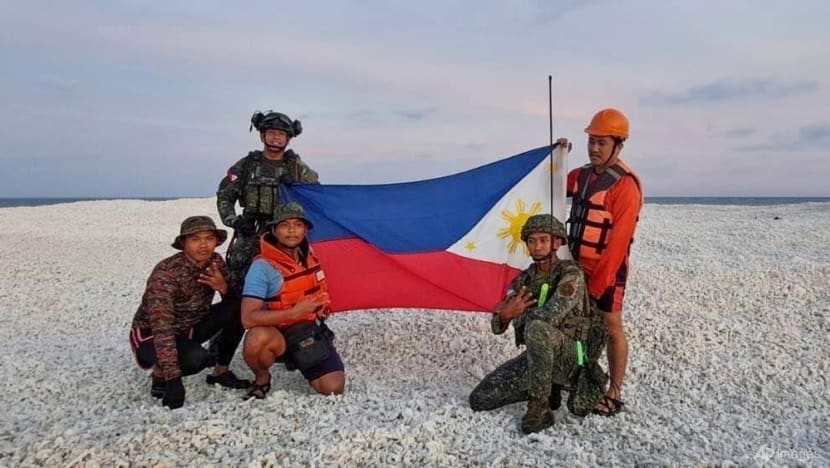Commentary: China is testing Trump in the South China Sea and the region is watching
The US President’s commitment to America’s key Southeast Asian ally was not seriously tested in his first term – this time things are different, says Asia Society’s Andrew Chubb.

A Chinese Coast Guard ship patrols the area as Philippine inter-agency members visit Sandy Cay 2 at the South China Sea on Apr 27, 2025. (File photo: AP/National Task Force West Philippine Sea)

This audio is generated by an AI tool.
LANCASTER, England: On Apr 25, Chinese state TV made an unusual announcement: The coast guard had “implemented maritime control” at Sandy Cay in the Spratly Islands, with images showing the national flag unfurled on the uninhabited sandbar.
The Philippines hurriedly dispatched a team to take similar photos to show it remained unoccupied.
The landing on the atoll, and the publicity given to it, drove home one of Beijing’s core messages to the region this year – the prospect of abandonment by an unreliable US administration.
China’s top diplomat, Wang Yi, made this clear in March. At his high-profile press conference during the annual Two Sessions in Beijing, he warned that “infringement and provocation will backfire, and those acting as others’ chess pieces are bound to be discarded”.
In case anyone had missed the point, China’s Ministry of Foreign Affairs released a standalone statement highlighting Mr Wang’s comments. Official comments have repeated the line ever since.
The Sandy Cay incident was typical of China’s efforts to place US commitment in the Indo-Pacific under the microscope. The sandbar is within plain sight of the Philippines’ main military outpost in the hotly disputed archipelago.
Beijing’s information release was also carefully timed – the American and Philippine militaries were conducting their annual Balikatan joint exercises in the South China Sea.
Meanwhile, US freedom of navigation operations (FONOPs) in the South China Sea appear to have once again been paused, as they were in 2017, against the backdrop of a US-China trade war where deals are expected to be made.
TESTING THE WATERS IN TRUMP 2.0
US President Donald Trump’s first term coincided with a lull in South China Sea tensions as the Philippines under then-President Rodrigo Duterte sought to attract Chinese economic assistance, while Beijing restrained its maritime agencies in the hopes of peeling away a US ally.
As a result, Trump’s commitment to the US’ key Southeast Asian ally was not seriously tested by events on the water. The situation in his second term is very different.
On Jan 24, a scientific team from the Philippine Bureau of Fisheries and Aquatic Resources abandoned a survey at Sandy Cay.
Videos released by the Philippines showed a Chinese Coast Guard ship blocking Philippine survey vessels and a military helicopter hovering at low altitude. China described its vessels as having “intercepted, controlled, warned and expelled” intruding Philippine ships from the area, and state media drew attention to the incident.
That was four days after Mr Trump’s inauguration and new Secretary of State Marco Rubio’s reaffirmation of the United States-Philippines Mutual Defense Treaty and the US’ “ironclad commitments” to the Philippines.
An even more dangerous encounter followed on Feb 19 near Scarborough Shoal, when a Chinese helicopter flew within 3m of a Philippine patrol aircraft near Scarborough Shoal, according to the Philippine Coast Guard.
Then there’s the matter of the Chinese Coast Guard ships’ lingering presence in the Philippines Exclusive Economic Zone between Scarborough Shoal and the coast of northern Luzon since January. The area, while inside Beijing’s nine-dash line, is well over 100km from any disputed territory.
March and April saw Beijing and Manila trading accusations after incidents in the air and at sea near Scarborough Shoal.
FREEDOM OF NAVIGATION
The Philippines’ maritime agencies are outmatched by the Chinese Coast Guard, which is the world’s largest white-hull force (as opposed to the “grey hulls” of the navy). Yet unlike in Duterte’s term, Philippine agencies are contesting Chinese activities and publicising incidents, citing President Ferdinand Marcos Jr’s commitment that “not a square inch of Philippine territory is surrendered to any foreign power”.
American FONOPs in the South China Sea are part of the calculus. They challenge China’s extra-legal claims in the South China Sea, by asserting navigation rights and sailing military vessels in disputed waters.
In 2017, the first Trump administration placed the existing FONOP programme on hold while the president sought to build a relationship with Chinese counterpart Xi Jinping.
At the time of writing, there have been no publicly reported FONOP in the South China Sea since Dec 6, 2024.

More frequent and visible assertions of presence and navigation by other states will be needed if the waterway is to remain international. There have been some signs that some may be willing to step up.
During a visit to Manila in March, British Foreign Secretary David Lammy released a video on social media asserting the United Kingdom’s interests in the South China Sea, emphasising its commitment to the United Nations Convention on the Law of the Sea (UNCLOS) – which the United States has not ratified – and criticising “dangerous and destabilising activities by China.”
EXTREME RISKS TO CONSIDER
If clashes continue, so do the odds of escalation, whether by intent or miscalculation.
The region must be prepared for potential serious incidents involving vessel damage or even casualties, and an unpredictable US response. Advanced US anti-ship missiles were deployed to the Philippines for the first time, during this year’s Balikatan drill.
Yet to deal with the problem at hand, the Philippines needs to expand its navy and civilian maritime law enforcement assets. Given Mr Trump’s struggles to boost US shipbuilding capacity, it seems unlikely Washington will be of much help in this regard.
Japan, South Korea and Australia are more likely partners. Each may view increased Philippine capability in the South China Sea as potential brake on Beijing’s strategic advances elsewhere in the region.
One other option is to bring the issue to the UN General Assembly (UNGA) via a resolution calling on China to comply with the 2016 arbitration ruling under UNCLOS.
While non-binding, a UNGA resolution could rally international attention and support and, as think tank CSIS’ Greg Poling has pointed out, could point the way to an advisory opinion from the International Court of Justice (ICJ).
Abandonment is not the only extreme policy risk that countries in the region need to think through. Under Mr Trump, the spectrum of Washington’s responses to such situations could range from acquiescence and non-involvement to reckless escalation.
Many US allies in the Indo-Pacific are understandably worried that they may become the next Ukraine – lectured and pressured into submission by their own ally.
The region needs to think through how to respond to maritime crises and forestall extreme scenarios that have become less remote possibilities.
Andrew Chubb is a Fellow on Chinese Foreign Policy and National Security at the Asia Society Policy Institute’s Center for China Analysis, and a Senior Lecturer at Lancaster University.

















